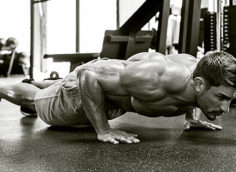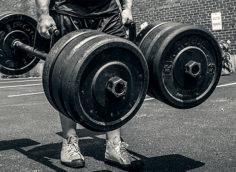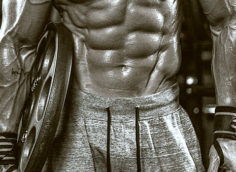Here's what you need to know...
- The author went from a body weight of 114 to 280 pounds using these techniques.
- Reps: That's what works to build a significant degree of mass. That means sets of between 8-20 reps. But you need to get stronger within a particular rep range.
- The "over warm-up" is a technique where you warm up past the weight you plan on using for your rep work. This allows you to do more reps with the working set than if you'd just worked up to the working-set poundage.
- 50% sets are where you take your work set to failure, rest 60 seconds, and then try to hit half the number of reps you hit on your initial set.
- The 350 Method is where you pick a weight and try to do it for 50 total reps over the course of three working sets.
Mass. As a young man, nothing grabbed my attention more than that word. It probably had to do with the fact that I weighed 114 pounds when I started training, and most of that was in the mop of hair that sat atop my head.
Once the iron hooked me, my desire to attain hypertrophy was surpassed only by my desire to inhale oxygen. I wanted to be that guy that got second and third looks in public. I wanted the admiration of other lifters and peers. I wanted "sleeve busting arms" and all of those other overdone slogans that defined what muscular mass entailed.
Those thoughts kept a fire lit under my ass during the time when progress was slow or absent and I felt like quitting. When you have that kind of passion for something, you really leave yourself with only one option: get better, or in this case, get bigger.
As such, I devoured every magazine and book I could find on training and eating for mass. I'm thankful I didn't have the internet back then because I'm positive I would've been paralyzed by the amount of information at my disposal. Since information was far more limited, I was forced to follow some guidelines and, over time, develop my own theories and methods that eventually served me quite well, well enough that I sit here writing this at a relatively lean 280 pounds.
The best thing about having a limited amount of information was that I was forced to put in the work and be introspective about what theories worked and which ones didn't. I didn't get bombarded with scientific studies or forum arguments between guys who weren't any bigger than I was. So I went to the source: big and strong guys.
More often than not, I found successful guys adhering to the same principles. I found out that I wasn't a special snowflake and that these principles worked just as well for me. I simply made adjustments to them based on my own personal preferences and recovery ability.
Here then are some of the most effective techniques I used over the years to really pack on the mass.
One of the rules of getting larger is that you must get stronger. I've never found a way around this dilemma. Eventually you must load the bar with more weight, for more reps, than you'd been using previously. But the key is a little word in that last sentence. Reps.
You need to get stronger within a particular rep range. That means sets of between 8 and 20 for the most part. Not singles, doubles, or triples.
There's a reason virtually every bodybuilder on the planet does lots of reps: because that's what works to build a significant degree of mass. What I've found to be most effective are sets of 8-12 for upper-body work and sets of 12-20 for lower-body work. We're talking training for hypertrophy here, not building maximum strength capability.
A lot of guys intertwine these ideas and don't really understand that while they can complement each other, you can't really train for maximum size while also training for maximum strength and vice versa. One will take a bit of a backseat to the other.
It's really two totally different animals and each requires a very different approach. Spend two years training for maximum size, getting stronger in the rep ranges I described above, and you'll more than likely build a higher 1-rep max, too. That's mostly a side effect of this type of training, and not the purpose of it.
You won't, of course, have gotten as strong as you would have if you'd spent that time working at developing maximum strength where you did lots of doubles, triples, and sets of 5. That's the kind of training that'll build maximum strength, and as a side effect, some muscle mass, but again, not as much as training for hypertrophy alone would have.
Specificity reigns. If you want to truly maximize your mass training, prioritize it. Train for that, and that alone.
In my early years, I took a very simple approach to my rep-work goals. I picked a weight I wanted to be able to lift X amount of times and I worked towards that goal.
For example, I remember wanting to be able to do 12 reps with 100-pound dumbbells in the incline press. At the time I was able to do sets of 7-8 reps on a pretty consistent basis, so I just stayed with them until I was able to consistently hit 12 reps and then I moved up to the 110's.
Simple progression. And it worked. This kept me very focused on achieving goals for months at a time and it kept me from deviating from routine to routine. I had rep goals for every movement and I didn't add weight until I hit those rep goals.
I also discovered something that made those sets even more effective. It's a little trick I call over warm-ups.
The over warm-up was a technique I used where I warmed up past the weight I planned on using for my rep work. What I found was that the over warm-up allowed me to consistently use more reps with the working set than if I'd just worked up to the working set.
For example, if you planned on squatting 315 for reps, your warm ups might look something like this:
- 135 x 10
- 225 x 5
- 275 x 4
- 315 x 3
- 335 x 2
- 365 x 1
- 315 x rep work
Because of my powerlifting interest I was later able to assign some intensity ranges associated with both the over-warm up and the work sets. The top over warm-up single ended up being about 85% of my max for both upper body and lower-body work. The lower-body work sets were done at around 70% of my max, while the upper-body work sets were done at around 75%.
The average Joe can generally hit about 8-10 reps at 75% of his max, and around 12 reps at 70%. There's some variation from person to person, but these ranges to work for most people.
As far as when to increase the weight, I'd bump it up when I could do 12-15 reps on the upper-body movements so that I'd go back to hitting 8-10 reps again. I'd do the same for lower body movements when I hit 18-20 reps. It's that simple.
One of the methods I found that worked incredibly well was something I picked up from Dr. Ken Leistner: 50% sets. This is where you take your work set to failure, rest 60 seconds, and then try to hit half the number of reps you hit on your initial set.
For example, if you bench-pressed 315 for 12 reps, you'd rest for 60 seconds and then try your best to hit 6 reps, i.e., half the number of reps you were able to do on the first set. This is a very effective strategy in terms of keeping focused because you're trying to essentially break three PR's:
- Total reps on the first set from the previous week.
- Reps on the 50% set.
- Total reps from both sets from the previous week.
The 350 Method is something I developed while playing around with powerlifting assistance work. You simply pick a weight that you try to do for 50 total reps over the course of three working sets.
I used this on incline presses often and found that when my 350 sets went up, so did my other pressing. This is a great (and painful) method for getting in a lot of rep work and can be used very effectively with any movement. For example, initially I picked 225 as my 50-rep weight. Generally, my sets fell into these kinds of ranges:
- 225 x 22
- 225 x 13
- 225 x 8
- Total reps = 43
I stayed with 225 until I was able to get the 50 total. After that I started going after 50 total reps at 275.
That may seem like quite a jump but when I finally reached 50 total reps with 225, I'd worked up to 30 reps on the first set (at that point I was well beyond 50 reps total for the three sets). I hit 18 reps the first time I tried the 350 Method with 275 on the incline, which is about a perfect starting point.
Let's put all of these principles together to create a mass-building template that will pay big dividends.
First off, the program has to be built around compound movements. That means for lower-body work we're talking squats, front squats, leg presses, split squats, and stiff-legged deadlifts. For upper-body work it's bench presses, incline presses, overhead pressing, barbell rows, chins, dips, and curls.
Also included will be unilateral work for the lower body since most people are terribly out of balance in that regard, and unilateral leg work is great for injury prevention.
There's no need to add in a million isolation movements. Lots of young guys get paralyzed by thinking they need to do every movement under the sun in order to get complete development when they should realize that getting brutally strong with high reps will build mass over the entire body.
You don't need four different kinds of curls and three different kinds of lateral raises to grow. If there's a lagging body part that needs to come up, then you deal with that later after you've laid down a solid layer of mass. You shouldn't be worried about "capped delts" when you weigh 137 pounds.
From a split perspective, simply having a lower-body day and an upper-body day that rotates is a great idea. You can train three times a week but actually hit both the lower body and upper body three times over two weeks.
Week 1
Lower Body #1
- A. Squat 85% x 1, 70% x AMAP, plus a 50% set
- B. Stiff Legged Deadlift 85% x 1, 70% x AMAP (no 50% set)
- C. Split Squat 5 sets of 10-20
Upper Body #1
- A. Bench Press 85% x 1, 75% x AMAP, plus a 50% set
- B. Incline Press 350 Method
- C. Barbell Row 2 sets of 8 then 2 sets of 12, as heavy as possible
- D. Pulldown (any grip or handle is fine) 350 Method
- E. Barbell Curl 350 Method
Lower Body #2
- A. Front Squat 85% x 1, 70% x AMAP, plus a 50% set
- B. Leg Press 350 Method
- C. Lunge (walking or in place) 5 sets of 10-20
Week 2
Upper Body #2
- A. Overhead Press 85% x 1, 75% x AMAP, plus a 50% set
- B. Weighted Dip 350 Method
- C. Dumbbell Row 350 Method
- D. Chin (wide, narrow, or v-bar) 5 sets of AMAP
- E. Dumbbell Curl 350 Method
Lower Body #1
- A. Squat 85% x 1, 70% x AMAP, plus a 50% set
- B. Stiff-Legged Deadlift 85% x 1, 70% x AMAP (no 50% set)
- C. Split Squat 5 sets of 10-20
Upper Body #1
- A. Bench Press 85% x 1, 75% x AMAP, plus a 50% set
- B. Incline Press 350 Method
- C. Barbell Row 2 sets of 8 then 2 sets of 12, as heavy as possible
- D. Pulldown (any grip or handle is fine) 350 Method
- E. Barbell Curl 350 Method
There's no point in writing an article about building mass without talking about food. Simply put, the routine and the methods above will work, and work damn well for building a bigger you. However, no mass building routine or method will work without an abundance of food coming into compliment the energy needed for training and growing.
Most guys that believe they eat enough usually don't. If there's one thing I can tell you about eating for mass when you're young and small, it's that eating enough can flat out be a chore. I remember days where I gagged at every meal because I was still full from the previous meal.
Pounding copious amounts of food isn't an option; it's really a requirement. There are plenty of options to make eating big easier in terms of preparation. Hamburger Helper, peanut butter and jelly sandwiches, adding healthy oils to your food and shakes, lots of whole eggs, baked potatoes, tuna, and oatmeal are all foods you can load up on that are easy to prepare and cheap in bulk.
The methods I have outlined here work. And they work very well. You have to put them into action and develop the mindset that nothing is going to stand in your way of breaking rep PR's, eating like a maniac, and sleeping like a baby.
Those are the key factors in growing. Stimulate, feed, rest, and repeat. That's literally the entire paradigm of growing more mass and filling out your currently underwhelming frame.




